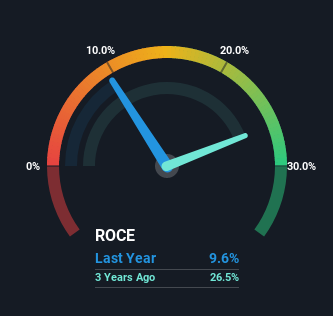If you're looking for a multi-bagger, there's a few things to keep an eye out for. Firstly, we'll want to see a proven return on capital employed (ROCE) that is increasing, and secondly, an expanding base of capital employed. Ultimately, this demonstrates that it's a business that is reinvesting profits at increasing rates of return. Although, when we looked at AVG Logistics (NSE:AVG), it didn't seem to tick all of these boxes.
Understanding Return On Capital Employed (ROCE)
For those who don't know, ROCE is a measure of a company's yearly pre-tax profit (its return), relative to the capital employed in the business. Analysts use this formula to calculate it for AVG Logistics:
Return on Capital Employed = Earnings Before Interest and Tax (EBIT) ÷ (Total Assets - Current Liabilities)
0.096 = ₹115m ÷ (₹2.5b - ₹1.3b) (Based on the trailing twelve months to September 2021).
So, AVG Logistics has an ROCE of 9.6%. On its own that's a low return on capital but it's in line with the industry's average returns of 10%.
View our latest analysis for AVG Logistics

While the past is not representative of the future, it can be helpful to know how a company has performed historically, which is why we have this chart above. If you want to delve into the historical earnings, revenue and cash flow of AVG Logistics, check out these free graphs here.
What The Trend Of ROCE Can Tell Us
When we looked at the ROCE trend at AVG Logistics, we didn't gain much confidence. Over the last five years, returns on capital have decreased to 9.6% from 32% five years ago. Although, given both revenue and the amount of assets employed in the business have increased, it could suggest the company is investing in growth, and the extra capital has led to a short-term reduction in ROCE. If these investments prove successful, this can bode very well for long term stock performance.
Another thing to note, AVG Logistics has a high ratio of current liabilities to total assets of 51%. This can bring about some risks because the company is basically operating with a rather large reliance on its suppliers or other sorts of short-term creditors. While it's not necessarily a bad thing, it can be beneficial if this ratio is lower.
The Bottom Line
In summary, despite lower returns in the short term, we're encouraged to see that AVG Logistics is reinvesting for growth and has higher sales as a result. And there could be an opportunity here if other metrics look good too, because the stock has declined 17% in the last three years. As a result, we'd recommend researching this stock further to uncover what other fundamentals of the business can show us.
AVG Logistics does have some risks, we noticed 3 warning signs (and 2 which are potentially serious) we think you should know about.
While AVG Logistics may not currently earn the highest returns, we've compiled a list of companies that currently earn more than 25% return on equity. Check out this free list here.
New: Manage All Your Stock Portfolios in One Place
We've created the ultimate portfolio companion for stock investors, and it's free.
• Connect an unlimited number of Portfolios and see your total in one currency
• Be alerted to new Warning Signs or Risks via email or mobile
• Track the Fair Value of your stocks
Have feedback on this article? Concerned about the content? Get in touch with us directly. Alternatively, email editorial-team (at) simplywallst.com.
This article by Simply Wall St is general in nature. We provide commentary based on historical data and analyst forecasts only using an unbiased methodology and our articles are not intended to be financial advice. It does not constitute a recommendation to buy or sell any stock, and does not take account of your objectives, or your financial situation. We aim to bring you long-term focused analysis driven by fundamental data. Note that our analysis may not factor in the latest price-sensitive company announcements or qualitative material. Simply Wall St has no position in any stocks mentioned.
About NSEI:AVG
AVG Logistics
Engages in the provision of logistics services in India, Bangladesh, and Nepal.
Slight risk with mediocre balance sheet.
Similar Companies
Market Insights
Community Narratives



